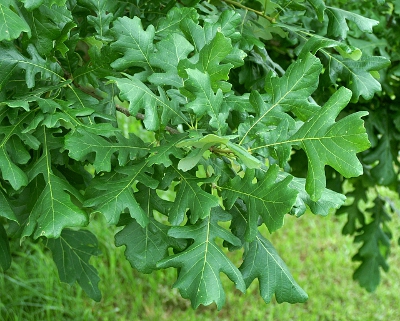Bur Oak Tree
Category: Deciduous Trees

Facts about Bur Oak Tree, "Scientific name for Bur Oak Tree is Quercus macrocarpa". The Bur oak tree is sometimes known as the Mossy cup oak, Burr oak, Mossy cup white oak or the Quercus macrocarpa. The Bur Oak Tree comes of an oak species of the Quercus sect which is native to Canada and North America especially the areas around mid-western and eastern USA. Bur Oak Tree is a large deciduous plant which can grow up to a height of about 70 to 80 feet (21.33 to 24.38 meters) and can grow 100 feet (30.48 meters).
The Bur Oak Tree is massive with its trunk spreading about ten feet (3.04 meters). However, the tree has a slow growth rate with only a growth of about (30 cm) in a year. A well-established Bur Oak Tree can have a height of approximately 10 feet (3.04 meters) after a period of twenty years. The Bur Oak Tree has a life expectancy of about two hundred to three hundred years. Some can live up to four hundred years.
The Bur Oak Tree has green foliage with irregularly and deeply lobed, simple leaves which can grow to a length of four to ten inches (10 to 25.4 cm) with a spread of two to 4 1/4 (5 to 10.6 cm) inches. The Bur Oak Tree leaves margins are rarely rounded at the base and the upper surface has a semi-glossy appearance and a pubescent below. The leaves color can be dark green with a lustrous above and a grayish to whitish green underneath. Upon maturity and fall, the leave turn to tarnish-brown.
The Bur Oak Tree produces buds which have an alternating arrangement and a grayish-brown color with a pale pubescence cover. These buds can either be broadly ovate, imbricate or cone-shaped and can grow to about one eight to a quarter inches (.3 to .6 cm) producing greenish-yellow catkins as its flowers. The catkins are usually developed in spring with the male having a yellow greenish color and the females being reddish in color. The Bur Oak Tree flowers give way to fruits, acorns. These acorns are 3/4 to 2 inches (2 to 5 cm) long and 3/4 to 1 1/2 inches (2 to 4 cm) wide and have a large fringe-cupped wrapping. The Bur Oak Tree has a dark grey colored bark which has deep furrows and ridges.
A Full grown Bur Oak Tree can absorb as much as 48 pounds (21.77 kg) of carbon dioxide a year. The same Bur Oak Tree could also produce enough oxygen in a day for two people. In a single day, a large Bur Oak Tree can drink up to 100 gallons (378.5 liter) of water from the ground and discharge it into the air.
You can tell a Bur Oak Trees age by the number of growth rings inside. Growth rings size shows what kind of conditions accrued that year, the temperature and if it was a dry or wet year.
Bark of the Bur Oak Tree protects it from the elements and is made up of dead cells.
The Bur Oak Tree can do well in USDA hardy zone two and in a wide variety of soil conditions. However, it can do best in moist to well-drained loamy soils with pH of five to eight and in full sun. The Bur Oak Tree can tolerate both dry conditions and moderate shade.
Bur Oak Tree roots usually grow two to three times the width of the tree branches. The ideal time to fertilize your Bur Oak Tree is in late fall or early spring. If you want to transplant a Bur Oak Tree do it in fall, this is ideal for most trees.
Bur Oak Tree leaves are made up of many colored pigments, green chlorophyll hides the colors during the growing season of spring and summer. As days get shorter and cooler temperatures come in the fall, it cause the chlorophyll to break down and than the other color pigments can be seen.
Bur Oak Tree growth is referred to as Meristem (The undifferentiated embryonic plant tissue from which new cells are created, as that at the tip of a root or stem). This tissue can be found at the tips of shoots and leaves. Inside the stem growth in thickness occurs at the vascular cambium.
Bur Oak Trees make their own food from sunlight, carbon dioxide, water, and nutrients from the soil.
The Bur Oak Tree can be used to produce wood for fencing, firewood and lumbering. Its fruits are food for the wild life. It can also be used to make antiseptics.

 Back To Category Deciduous Trees
Back To Category Deciduous Trees